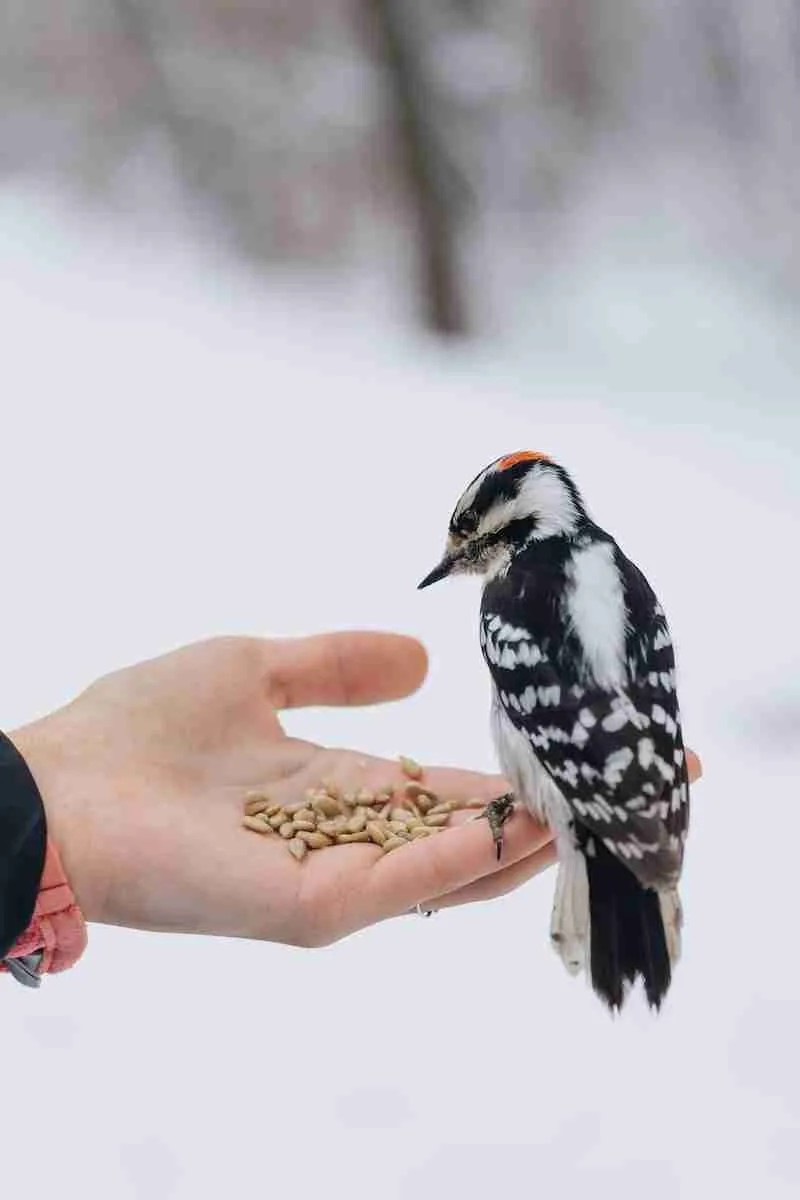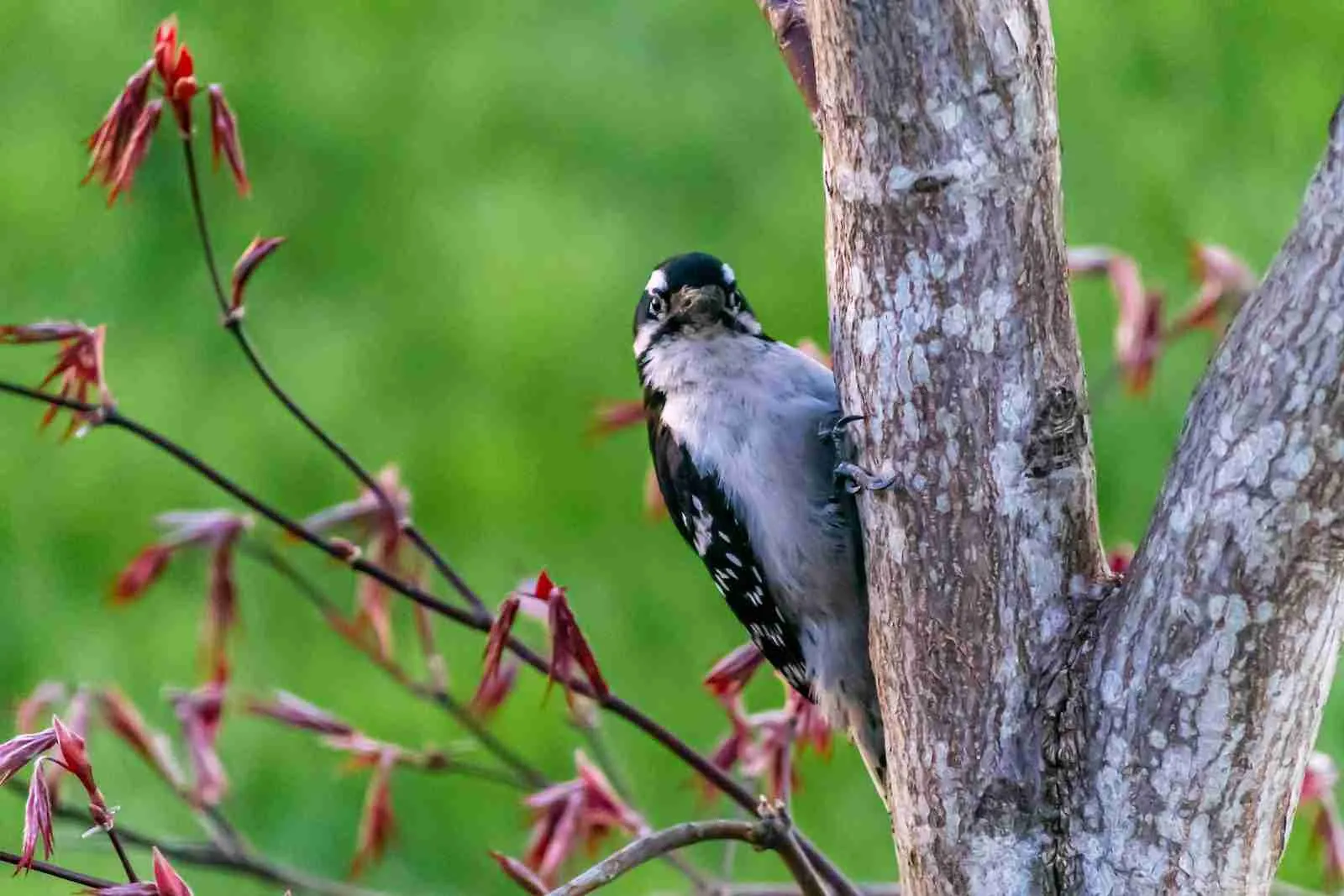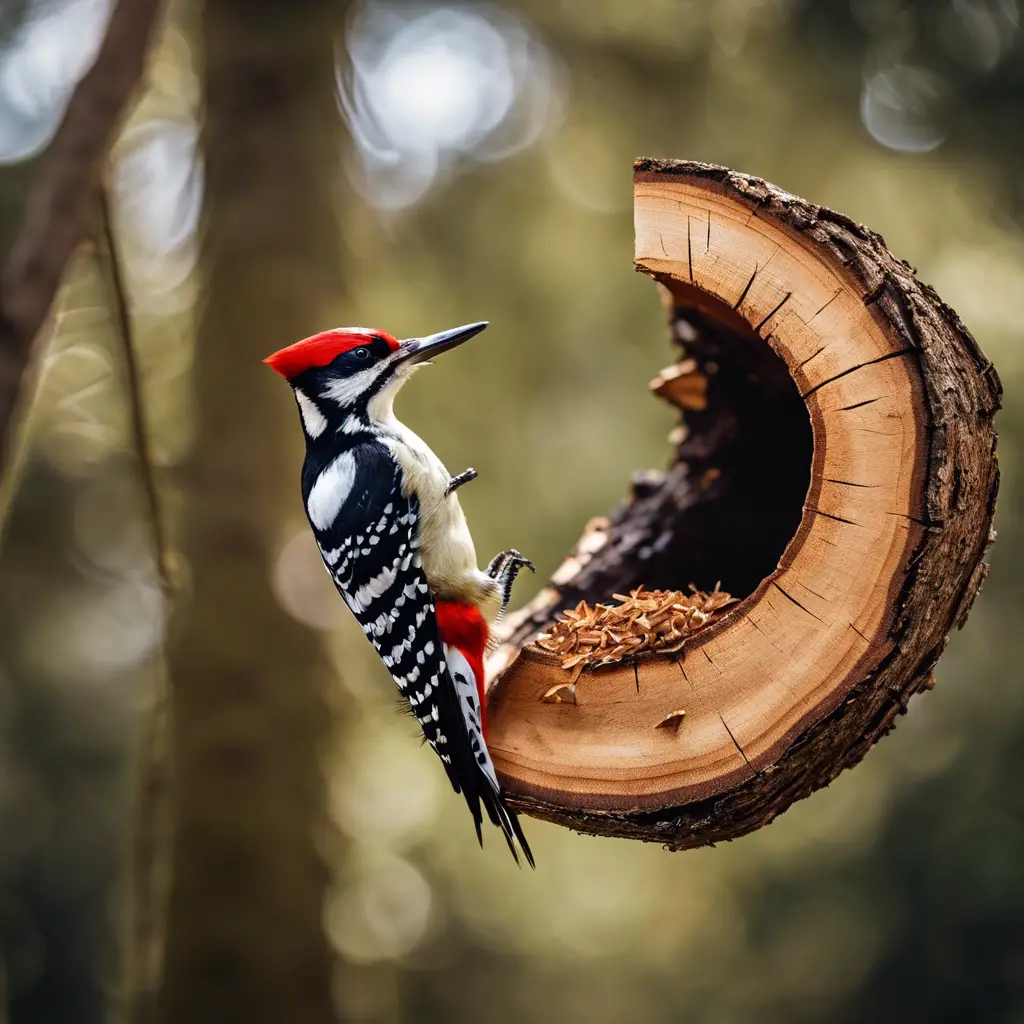If you’re a bird enthusiast, you’ll love the woodpeckers in Louisiana! These birds are fascinating to watch and can be found throughout the state. In this blog post, we will discuss the different types of woodpeckers that can be found in Louisiana. We will also provide some tips on how to identify these birds. So if you’re looking to add some new feathered friends to your life, keep reading!
Only accurate sources and an Ornithologist were used to verify the data.
Most Common Woodpeckers of Louisiana
Ivory-coloured Woodpeckers

The Ivory-coloured Woodpecker is a small to medium-sized woodpecker found in the southeastern United States. The adult male has a black back, wings and tail, with an ivory-colored head, breast and belly. The female is similar but lacks the black on the head. Both sexes have white stripes on the wings and tail. Juveniles are brownish with white streaks on the back and wings.
The Ivory-coloured Woodpecker is a cavity nester and excavates its own nest hole in a dead tree or limb. Both sexes will hammer loudly on trees or metal objects to declare their territory. This woodpecker feeds mainly on insects, especially beetles and ants. It will also eat fruits, nuts, and berries.
The Ivory-coloured Woodpecker is a year-round resident of Louisiana. Look for them in woodlands, especially near streams or swamps. These birds are relatively common but may be declining in some areas due to habitat loss.
When identifying an Ivory-coloured Woodpecker, look for the following characteristics:
- Small to medium size
- Black back, wings and tail
- Ivory-colored head, breast and belly
- White stripes on wings and tail
- Loud hammering sound
Northern Flicker
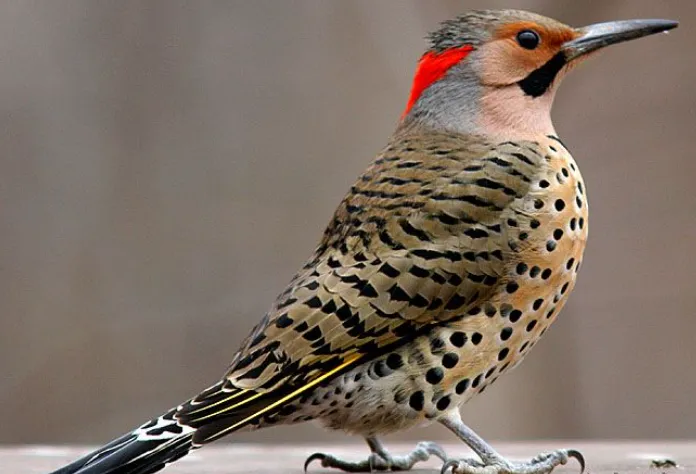
The Northern Flicker is a large, brown and black bird with a distinctive red breast. They are the only North American woodpecker with this coloring. The underparts are white with black bars, and the back is brown with black spots.
The wings are brown with black bars, and the tail is black with white bands. The bill is long and slightly curved. Northern Flickers are about 15 inches in length with a wingspan of 23 inches.
Northern Flickers are found in woodlands, forests, parks, and backyards across North America. They prefer open areas with trees for nesting and foraging. These birds eat mainly ants and other insects, but will also eat fruits, berries, and seeds.
Northern Flickers are known for their loud calls, which sound like “wicka-wicka-wicka.” They are also known for their drumming behavior, in which they rapidly tap their beaks against a hard surface.
This behavior is used to communicate with other birds and to attract mates.

Yellow-bellied Sapsucker
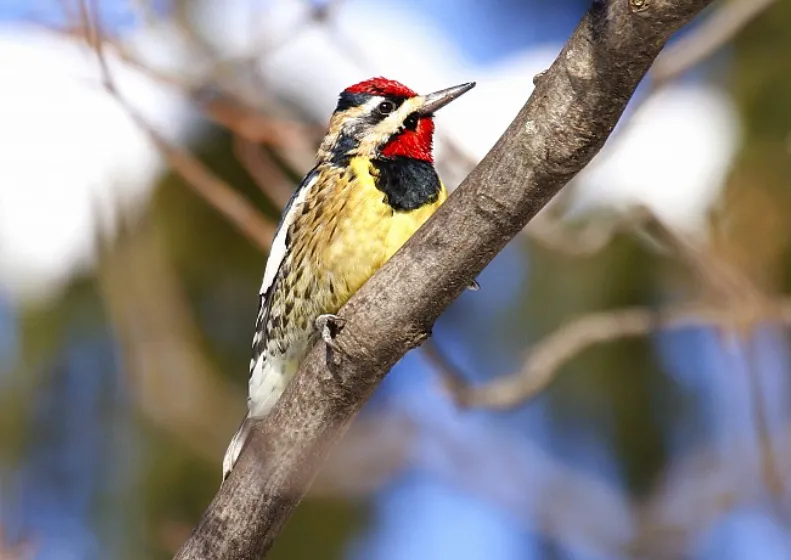
The Yellow-bellied Sapsucker is a medium-sized woodpecker that ranges in length from 15 to 18 cm.
They have black and white plumage with a yellow wash on their belly and flanks. The male has a red crown, while the female has a black crown with white stripes. Juveniles are similar in appearance to adults but lack the red or black crowns.
These birds are most often seen in wooded areas where they can find trees to drill holes into for sap and insects.
The Yellow-bellied Sapsuckers are year-round resident woodpeckers in Louisiana. However, they may be more difficult to spot during the winter months when they are less active. During the breeding season, which runs from February to August, these birds can be found in pairs or small family groups.
They nest in tree cavities that they excavate themselves. The female will lay a clutch of between three and seven eggs. Both parents help to incubate the eggs and care for the young birds once they hatch.

Red-headed Woodpeckers
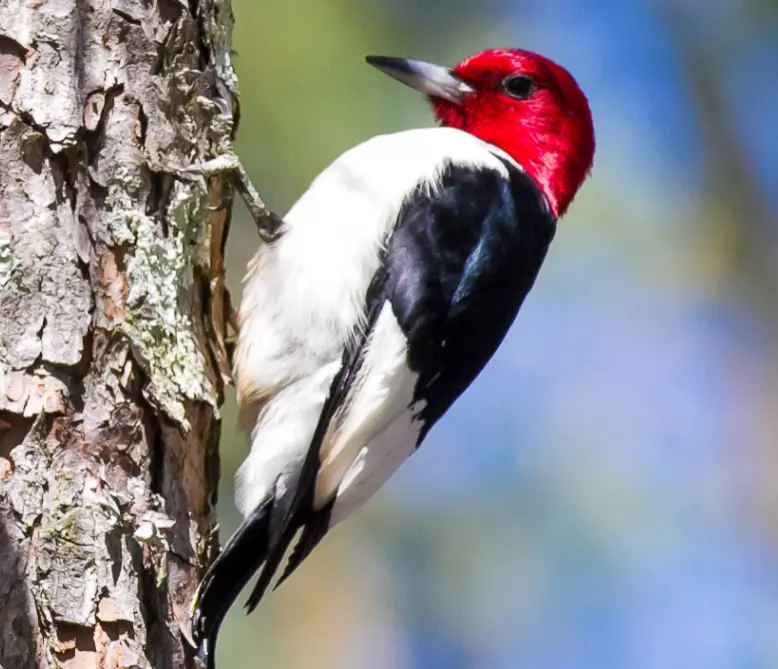
The red-headed woodpecker is one of the most easily recognized and popular birds in North America. Louisiana is home to a healthy population of these striking black, white, and red creatures.
Though they may be small, only about seven inches long on average, their striking plumage and behavior make them hard to miss. Keep an eye out for the following characteristics and behaviors to help you identify a red-headed woodpecker.
One of the most distinguishing features of the red-headed woodpecker is, of course, its bright red head. The rest of the bird’s body is mostly black with white stripes running down its back.
Adult males usually have a completely red head, while females usually have a red head with a small black patch on the back of the neck. Juvenile birds are similar to adults but their plumage is duller and they often have a brownish wash over their bodies.
In addition to its bright plumage, the red-headed woodpecker is also known for its loud call. The bird’s call has been described as sounding like a toy drum being hit with a stick.
If you hear this sound, look up into the trees and you’re likely to see the source: a red-headed woodpecker drilling its beak into the bark in search of insects.
Red-headed woodpeckers are also known for their acrobatic flying. Watch for these birds darting through the trees and you’ll see them twist and turn in the air as they chase after insects.
They are also known to hang upside down from branches, a behavior that often surprises onlookers.

Related post: Types of Woodpeckers in Oregon
Downy Woodpeckers
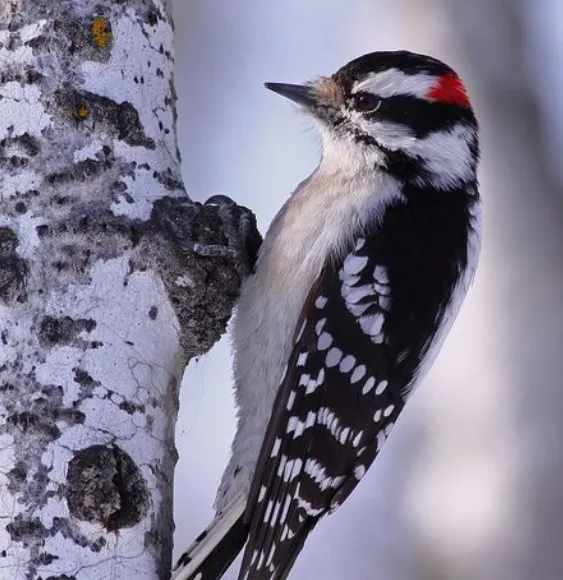
The Downy Woodpecker is the smallest woodpecker in North America, measuring about six inches in length with a wingspan of approximately ten inches. The male has a black back and white belly, while the female’s back is mostly white with some black spotting.
Both sexes have a white line running down the center of their backs, as well as a black cap and white cheeks.
The Downy Woodpecker is found in wooded areas across North America, including parts of Canada and Mexico. In the United States, they are most commonly seen in the eastern half of the country. These birds prefer to nest in trees, but will also build their nests in wooden buildings or houses.
The Downy Woodpecker is a proficient flyer and an expert at maneuvering through trees. They are also known to be very curious birds, often investigating anything new in their environment.
When foraging for food, these woodpeckers will use their strong beaks to peck at tree bark or poke holes in dead trees in search of insects.
If you see a small woodpecker with black and white markings in your backyard, chances are it’s a Downy Woodpecker! These little birds are common across North America and are relatively easy to spot.

Pileated Woodpeckers
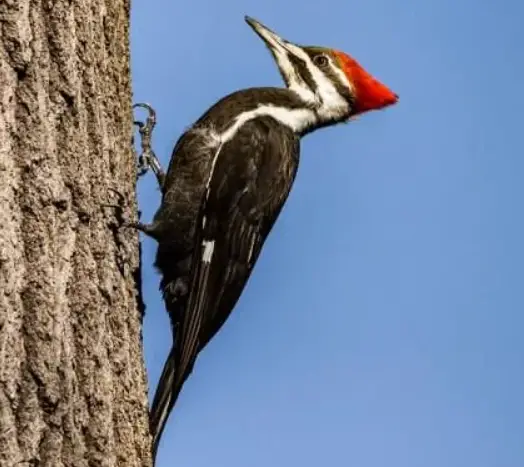
The Pileated Woodpecker is the largest woodpecker in North America, measuring 19 inches in length with a wingspan of up to 30 inches. They are black with white stripes on their face and neck, and have a red crest on their head.
Both sexes look alike. These birds are very powerful fliers and can be seen swooping down from high perches to catch insects in mid-air.
Pileated Woodpeckers are found in forests throughout North America. In Louisiana, they are most commonly seen in the southern and central parts of the state.
These birds prefer mature forests with large trees that have dead or dying limbs. This provides them with the perfect environment for their primary food source: wood-boring insects.
Pileated Woodpeckers are most active during the day, although they may be seen feeding at night if there is a bright moon. They make a loud “kuk-kuk-kuk” call that can be heard from long distances.
If you are lucky enough to see one of these birds up close, you will be able to watch them hammering away at tree trunks with their powerful beaks. This behavior not only allows them to find food, but also creates nesting cavities that can be used by other animals.

Red-naped Sapsucker
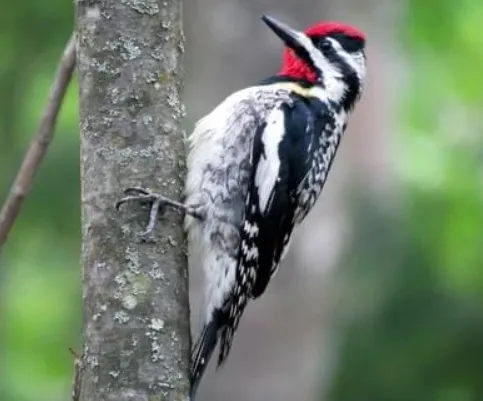
The Red-naped Sapsucker is a small, woodpecker-like bird with a black back, white belly, and rusty red head. They are known to drill perfectly round holes in trees in order to feed on the sap that flows out.
Although they will drill these sapsucker wells year-round, they seem to be most active during the breeding season. The male will often give a loud “yank-yank-yank” call while perched atop a tree or fence post.
These calls are thought to attract females and also warn other males away from their territory. If you’re lucky enough to spot a Red-naped Sapsucker, you’ll likely see it feeding on tree sap or insects, or excavating a new sapsucker well. Keep your eyes peeled for this little bird the next time you’re out in nature!

Woodpeckers: Picoides
Woodpeckers are one of the more easily identified birds in North America. There are several identifying characteristics that can help you tell a woodpecker apart from other birds. Woodpeckers have strong beaks and bills that they use to chisel away at tree bark to find food or make nests.
They also have long tongues that they use to reach deep into crevices to catch insects. Woodpeckers have zygodactyl feet, which means that two of their toes point forward and two-point backward. This helps them grip onto tree branches as they climb up and down trees.
Woodpeckers are generally small to medium-sized birds, and they come in a variety of colors including black, white, brown, and red. Male woodpeckers often have brightly colored heads, while females usually have more subdued colors.
Woodpeckers are also known for their loud calls, which they use to communicate with other woodpeckers.
If you see a bird that you think might be a woodpecker, there are a few behaviors that can help you confirm that it is indeed a woodpecker. Woodpeckers are very active birds, and they are often seen climbing up and down trees. They also tend to hop rather than walk when they are on the ground.
And of course, one of the most distinctive behaviors of woodpeckers is their drumming. Woodpeckers will often tap their beaks against tree trunks or branches to create a loud, resonating sound. This drumming behavior serves several purposes, including mate attraction and territory defense.
Red-cockaded Woodpecker
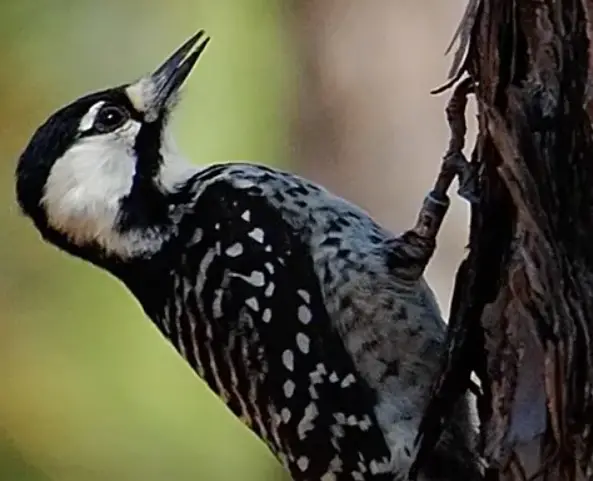
The red-cockaded woodpecker is a small to medium-sized woodpecker. The adult has a black back, white underparts, and a black cap. There are two white stripes on the face, one over each eye.
The male has a red streak on the side of the head, while the female has a yellow streak. The red-cockaded woodpecker is the only woodpecker in North America that excavates its own nesting cavities.
These cavities are usually located in living pine trees, and the bird will use the same tree for many years. The red-cockaded woodpecker is a social bird, living in family groups of two to six birds. The family group consists of a breeding pair and their immature offspring.
These birds are very territorial and will defend their territory from other red-cockaded woodpeckers. The red-cockaded woodpecker is an endangered species, due to habitat loss and fragmentation.

Red-bellied Woodpecker
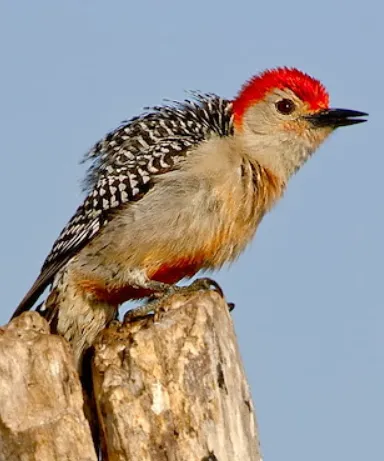
The red-bellied woodpecker is a medium-sized woodpecker with black and white plumage. The male has a red cap and nape, while the female has a red nape. The bird gets its name from the reddish color on its belly, which is visible when the bird is in flight.
The red-bellied woodpecker is found in woodlands and forests throughout the eastern United States and parts of Canada. The bird feeds on insects, nuts, and fruits. It often excavates its own nesting cavity in a tree.
The red-bellied woodpecker is a common sight at backyard bird feeders.

Hairy Woodpecker
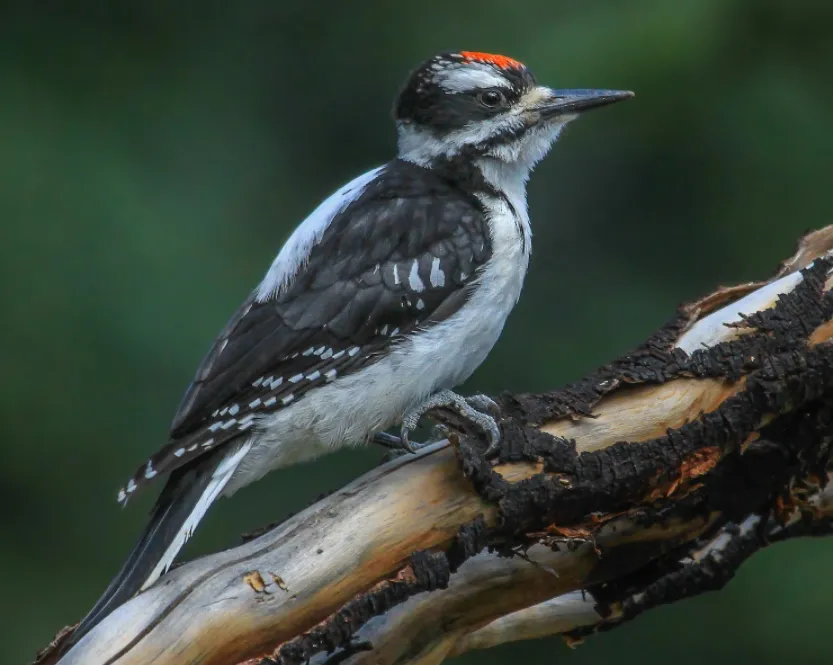
The Hairy Woodpecker is a small to medium-sized woodpecker that is found in North America. The bird has a black back and wings, with a white breast and belly. The head of the Hairy Woodpecker is black, with a white stripe running down the middle.
The bill of the bird is long and straight, and the tail is black with white stripes. The Hairy Woodpecker is a member of the Picidae family, which includes other woodpeckers, such as the Northern Flicker and Pileated Woodpecker.
The Hairy Woodpecker is found in forests across North America. The bird prefers to nest in trees, and will often excavate its own nest hole.
The Hairy Woodpecker will also use abandoned nests of other birds, such as the Northern Flicker. The bird is an important part of the forest ecosystem, as it helps to control insect populations.

How to attract woodpeckers?
Woodpeckers are some of the most interesting birds that you can attract to your backyard. They are unique in their habits and appearance, and they provide hours of enjoyment for bird watchers of all ages. If you’re wondering how to attract woodpeckers, read on for some helpful tips.
One of the best ways to attract woodpeckers is to provide them with a food source. Woodpeckers are primarily insectivores, so they will be attracted to areas where there are plenty of insects to eat. If you have a problem with insects in your yard, consider attracting woodpeckers as a way to control the population! You can also offer them suet or other bird-specific foods that will give them the energy they need to survive.
Another way to attract woodpeckers is to provide them with a place to nest. Woodpeckers are cavity nesters, which means they will excavate their own nesting sites in trees or deadwood. If you have a suitable tree in your yard, consider leaving it unpruned to provide a potential nesting site for woodpeckers. You can also purchase or build a nest box specifically designed for woodpeckers.
What kind of woodpeckers live in Louisiana?
Louisiana is home to two species of woodpeckers: the red-bellied woodpecker and the hairy woodpecker. Both of these birds are common sights at backyard bird feeders.
Does Louisiana have woodpeckers?
Yes, Louisiana has two species of woodpeckers: the red-bellied woodpecker and the hairy woodpecker. These birds are common sights at backyard bird feeders. You can attract them to your yard by providing a food source and a place to nest.
What is the biggest woodpecker in Louisiana?
The biggest woodpecker in Louisiana is the red-bellied woodpecker. This bird is a medium-sized woodpecker with black and white plumage. The male has a red cap and nape, while the female has a red nape. The bird gets its name from the reddish color on its belly, which is visible when the bird is in flight.

An avid ornithologist, zoologist and biologist with an unwavering passion for birds and wild animals.
Dr. Wilson’s journey in ornithology began in childhood and led him to obtain a Ph.D. in Ornithology from the prestigious Avian Research Institute. He has worked closely with renowned experts in the field and conducted extensive research and field studies globally.

